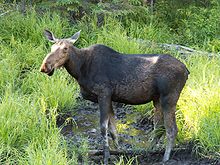European elk
| Moose | |
|---|---|
 |
|
| Male (bull) | |
 |
|
| Female (cow) | |
| Scientific classification | |
| Kingdom: | Animalia |
| Phylum: | Chordata |
| Class: | Mammalia |
| Order: | Artiodactyla |
| Family: | Cervidae |
| Subfamily: | Capreolinae |
| Genus: |
Alces Gray, 1821 |
| Species: | A. alces |
| Binomial name | |
|
Alces alces (Linnaeus, 1758) |
|
 |
|
| Moose range map | |
The moose (North America) or elk (Eurasia), Alces alces, is the largest extant species in the deer family. Moose are distinguished by the broad, flat (or palmate) antlers of the males; other members of the family have antlers with a dendritic ("twig-like") configuration. Moose typically inhabit boreal forests and temperate broadleaf and mixed forests of the Northern Hemisphere in temperate to subarctic climates. Hunting and other human activities have caused a reduction in the size of the moose's range over time. Moose have been reintroduced to some of their former habitats. Currently, most moose are found in Canada, Alaska, New England, Fennoscandia, Baltic States, and Russia. Their diet consists of both terrestrial and aquatic vegetation. The most common moose predators are the gray wolf along with bears and humans. Unlike most other deer species, moose are solitary animals and do not form herds. Although generally slow-moving and sedentary, moose can become aggressive and move quickly if angered or startled. Their mating season in the autumn features energetic fights between males competing for a female.
Alces alces is called a "moose" in North American English, but an "elk" in British English; its scientific name comes from its name in Latin. The word "elk" in North American English refers to a completely different species of deer, the Cervus canadensis, also called the wapiti. A mature male moose is called a bull, a mature female a cow, and an immature moose of either sex a calf.
...
Wikipedia

